NEW YORK -- The New York Times revealed Friday that it withheld reporting on missing American Robert Levinson’s ties to the CIA for six years, one day after The Associated Press acknowledged withholding that detail for three years.
ABC News also said Friday that the network had known of Levinson’s CIA ties “for years.” ABC News said that Levinson's family and U.S. officials had urged the network not to disclose the information for fear that his life could be put in increased danger.
Levinson, a retired FBI agent, disappeared off the coast of Iran in March 2007. The U.S. government had maintained since then that Levinson was working as a private investigator looking into cigarette smuggling at the time of his disappearance.
But as the AP revealed Thursday, that "was just a cover story." In a deeply reported piece that could be turned into a plot on "Homeland," the AP described how Levinson was secretly paid to do intelligence gathering for the agency, an "extraordinary breach of the most basic CIA rules." Behind closed doors, several officials working with Levinson resigned or were reprimanded over the rogue mission.
The Huffington Post learned Friday morning that the Times had also been aware that Levinson was working for the CIA and declined to report it. The paper published a piece by Barry Meier later on Friday, “A Disappearing American Spy, and a Scandal at the C.I.A.”
Meier wrote that the Times had known of Levinson’s relationship to the CIA “since late 2007, when a lawyer for the family gave a reporter access to Mr. Levinson’s files and emails.” The paper, he wrote, “withheld that information to avoid jeopardizing his safety or the efforts to free him.”
In an interview with The Huffington Post, Meier said that Levinson’s story brought him into “a whole other world than I had ever ventured into in my life.”
Meier covers medical industry issues for the Times, not national security and intelligence. So his byline may seem out of place on a story about international intrigue, a secret spy mission and a government cover-up.
After finishing a series on defective heart defibrillators, Meier said he was searching for a new story to dig into and read about how Levinson disappeared in Iran while supposedly investigating cigarette smuggling. “It just sort of piqued my interest,” he said.
Meier had reported on the tobacco industry for The Times and so he already knew a bit about the smuggling world. He said he spoke to several cigarette industry investigators, who told him Levinson’s disappearance seemed strange to them. Through an intermediary, he eventually made contact with Levinson's wife, Christine, and David McGee, the family's lawyer.
Meier said he was invited to come to Florida and look through Levinson’s belongings as a way to “shed some light on what happened.” Meier, by his account, spent five days in late 2007 going through boxes of files and printed-out emails. He found Levinson’s contract with the CIA and field reports he’d been providing to the agency. He said that was when he realized Levinson had been working for the agency in Iran, and he alerted editors at The Times.
Meier said he “spent nine months to a year using those documents and his emails to reconstruct what had happened, to talk to the people involved.”
But despite such access and deep reporting, The Times missed out on advancing the story ahead of its competitors. On Dec. 9, 2011, the AP reported on a hostage tape, filmed the previous year, showing that Levinson was still alive. That same day, Meier published his own story about the tape for the Times, acknowledging he’d been permitted to view it the previous year but didn't report on it at the family's request.
In Friday’s story, Meier noted that the Levinson family dropped its objection to the Times publishing its piece once the AP story ran.
Though the Times wasn't ultimately the outlet that broke the news, Meier said he his editors were comfortable with their decision to hold the story, after having several discussions over the years about how to proceed.
While news organizations have held back details about the CIA before at the government's request -- from information about the 2012 Benghazi attack to the existence a secret drone base in Saudi Arabia -- it's unusual for a bombshell to remain hidden for as long as three years, or in the Times' case, six years.
The AP showed restraint in holding onto such an explosive story for so long, but the news organization still faced criticism for its decision to publish the news Thursday.
The White House said Thursday night it had “strongly urged" the AP not to publish the story. Sen. Bill Nelson (D-Fla.), one of Levinson's home state senators, said Friday that he had personally urged AP executive editor Kathleen Carroll not to run it.
Carroll said in a statement Thursday that the news organization had waited to publish the story until after government officials announced their efforts to find Levinson had "hit a wall."
“In the absence of any solid information about Levinson’s whereabouts, it has been impossible to judge whether publication would put him at risk,” Carroll said. “It is almost certain that his captors already know about the CIA connection but without knowing exactly who the captors are, it is difficult to know whether publication of Levinson’s CIA mission would make a difference to them. That does not mean there is no risk. But with no more leads to follow, we have concluded that the importance of the story justifies publication.”
The AP’s story was written by Matt Apuzzo and Adam Goldman, who won a Pulitzer Prize for their coverage of the NYPD’s Muslim surveillance program and have prompted three separate leak investigations over their deep reporting on intelligence and counter-terrorism.
Goldman, who recently joined The Washington Post, also prepared a separate piece on Levinson, which the newspaper published shortly after the AP’s story hit the wire.
Washington Post executive editor Marty Baron told HuffPost that the paper hadn't been waiting on the AP to publish first, but was "wrapping up editing matters on it.”
Baron also defended the decision to publish the material, telling HuffPost that the Levinson story “contained important revelations about the CIA that deserved ultimately to be disclosed.”
“The story had been held for years by the AP, but such a story shouldn't be held forever,” Baron said. “Enough time had passed."
